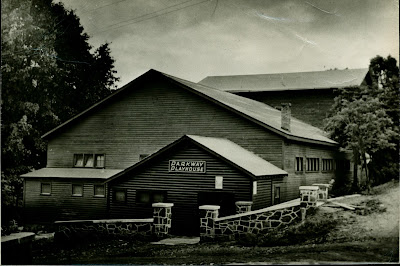The most significant event to happen to early campus dramatics was the arrival of Raymond Taylor, who joined the English Department in 1921 as a professor of speech. He would go on to become the school’s Director of Drama for the next thirty years. Taylor was a very qualified hire, having a Bachelor’s degree from the University of North Carolina at Chapel Hill and a Master’s degree from Harvard. Although College president Julius Foust was not convinced that dramatics should be included in the school’s official curriculum, Taylor was eventually allowed to teach courses in theatre production and playwriting, as well as speech. Foust also was not supportive of the female students dressing in pants, even for theatre productions, but Taylor purchased men’s suits for the young women to wear when they were playing male roles. He pushed the rules even further when he allowed students to smoke cigarettes on stage, an activity strictly forbidden by the College.
Under Taylor’s guidance, the Dramatic Club became The Dramatic Association of the North Carolina College for Women (now The University of North Carolina at Greensboro) and finally, in 1924, the Playlikers, which became the only campus organization allowed to perform plays. That year, the students performed five plays featuring both students and faculty. In 1925, the students took one of their production, Will-o’-the-Wisp, to Chicago for the National College Theatre Tournament and won second place. Taylor also accompanied his students to New York to see plays featuring famous stars, such as Ethel Barrymore, and to visit sites such as the Metropolitan Museum, the Aquarium, and the Statue of Liberty. In 1926, the Playlikers first performed plays written by students, specifically, a tragedy titled The Quick and the Dead, set in Eastern North Carolina, and a comedy titled Sims. Taylor also established the Masqueraders, an honorary dramatic society.
Eventually, the Playlikers would include not only students, but also members of the community in their productions. This added much-needed male participants to the all-girl school performances, now held at Aycock Auditorium (currently UNCG Auditorium). By the 1930s, the students were offering one play per month to audiences of over 2000 people. Perhaps recognizing that his students lacked proper stage elocution, Taylor requested that the College add two speech specialists to the faculty. He commented that his students showed “nasality, lisping, harshness, weak and thin voice texture, lack of breath control, sameness and monotony of tone, drawling and stuttering, exaggerated and disagreeable sectional accents, nervous rapidity, faulty enunciation and pronunciation, [and] affected elocution.”
 |
| The Parkway Playhouse |
The venue for campus programs expanded in 1941 when an amphitheater was constructed as part of a Works Project Administration (WPA) project. It had a seating capacity of 2500 people and included an outdoor stage to be used for May Day celebrations, plays, and pageants. Additionally, the 1940s ushered in a summer repertory program which would eventually move to the small town of Burnsville, North Carolina. Located in the Blue Ridge Mountains, the theatre would be called the “Parkway Playhouse.”
In the late 1940s, Taylor began to lose control of the program, and a growing lack of student interest caused the Playlikers organization to “disintegrate.” Finally, in 1949, the faculty advisory committee recommended that the College hire a new director of Dramatics, and Raymond Taylor, once considered the father of the school’s Dramatic program, was removed from leadership. Although he had less administrative responsibilities, Taylor continued to teach until his retirement in 1960, and when a new theatre was constructed on campus in 1967, it was named in his honor.
By Kathelene McCarty Smith


